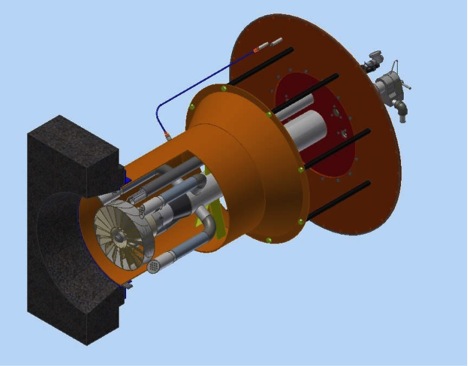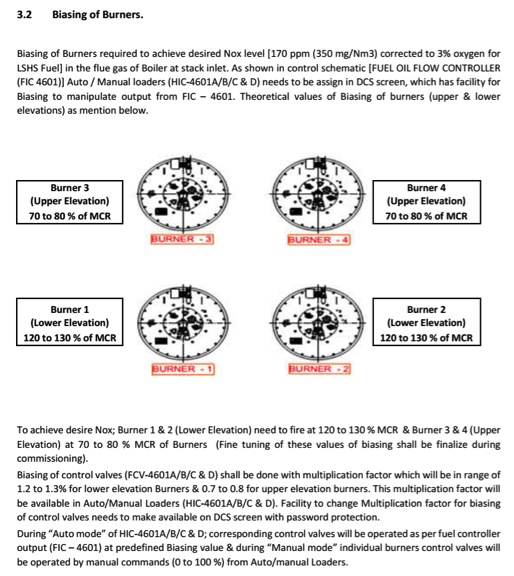Customer & End User: MANGALORE REFINERY & PETROCHEMICALS LTD.
Installation: CPP-01, 7 X 140TPH BOILERS LOW NOX BURNER RETROFIT
Abstract. In order to reduce the emission of nitrogen oxides in these oil-fired boilers, the effects of excess air ratio and staged combustion by way of biasing the firing between two tiers of burners coupled with Zeeco designed Y-Jet Oil Tips, the generation of nitrogen oxides is significantly reduced.
Introduction
The impact of NOx on the environment is receiving more and more attention. The emission standards for boiler air pollutants is getting very stringent. From this point of view, it is necessary to effectively control the nitrogen oxides produced during the combustion process to achieve low nitrogen combustion.
NOx emissions abatement and control by primary measures are divided into the following categories:
• Burner optimization (excess air control, burner fine tuning)
• Air staging (overfire air or two stage combustion)
• Flue gas recirculation
• Fuel staging (some burners out of service, reburning, lean-burn premixed combustion)
• Low NOX burners
As a commonly used method for reducing nitrogen oxides, flue gas recirculation is widely used in industry and is divided into internal flue gas recirculation and external flue gas recirculation. Internal flue gas recirculation refers to the structural design of the burner and the furnace (including the entrainment of high-speed jets, swirling or bluffing of the bluff body), so that the flue gas is recirculated and returned to the combustion zone in the furnace to participate. The flue gas external circulation is to spray a part of the lower temperature of the boiler tail into the furnace to reduce the oxygen content in the furnace and make the natural gas stay in an anoxic combustion state, thereby reducing the combustion temperature and reducing the formation of nitrogen oxides.
POLLUTANTS AND CONTROL TECHNIQUES
Combustion of standard fossil fuels (natural gas and ASTM Grade Oil) in commercial and industrial boilers results in the following nine emissions; carbon dioxide, nitrogen, oxygen, water, carbon monoxide, nitrogen oxide, sulfur oxides, volatile organic compounds, and particulate matter. The latter five products of combustion are considered pollutants and are known to, either directly or indirectly, cause harmful effects on humans and the environment.
NITROGEN COMPOUNDS (NOx)
Although there is evidence proving NOx is harmful to humans, the main reason NOx is considered an environmental problem is because it initiates reactions that result in the production of ozone and acid rain. Ozone and acid rain can damage fabric, cause rubber to crack, reduce visibility, damage buildings, harm forests and lakes, and cause health problems. By controlling NOx levels, along with the other pollutants, the levels of acid rain and ozone can be reduced.
The principal nitrogen pollutants generated by boilers are nitric oxide (NO) and nitrogen dioxide (NO2), collectively referred to as NOx. The contribution from different NOx sources to the total NOx levels varies among metropolitan areas. In industrial boilers, NOx is primarily formed in two ways; thermal NOx and fuel NOx: Thermal NOx is formed when nitrogen and oxygen in the combustion air combine with one another at the high temperatures in a flame. Thermal NOx makes up most of the NOx formed during the combustion of gases and light oils.
While flame temperature primarily affects thermal NOx formation, the amount of nitrogen in the fuel determines the level of fuel NOx emissions. Fuel containing more nitrogen results in higher levels of NOx emissions. Most NOx control technologies for industrial boilers, with inputs less than 100 MMBtu/hr, reduce thermal NOx and have little effect on fuel NOx.
Conditions of PGTR:
- Boiler Operation at 100% BMCR with N-1 Burners
- Boiler Operation at 57% BMCR with ALL Burners
- Boiler Operation at 100% BMCR with ALL burners
Data on the effect of several combustion modifications on the formation of nitrogen oxides and on boiler efficiency were acquired and analyzed for a 140 TPH oil fired utility boiler. The results from the study showed that decreasing the oxygen in the flue gas reduced the NOX formation by 33% and gave better boiler efficiencies.
Biased combustion was found to reduce the NOX emissions by as much as 55 % while no decrease in the efficiency. Adjustment of the boiler combustion air duct by providing turning vane baffles based on physical model airfoil studies helped in reduced the NOX formation.
The boilers were originally operating at almost 380 ppm before changeover to Zeeco’s Low NOx GB Burners, after the changeover they are now operating at 180 ppm at full MCR.
The lowest NOX emissions of 180 ppm (at about 1.6 % O2) in the stack was obtained by biasing the fuel flow in the top and bottom tier burners by 10%. The reduction of nitrogen oxides (NOX) emissions from steam boilers has been under study for several years. The NO* from boilers consist almost entirely of nitric oxide (NO) and nitrogen dioxide (NO2) with NO2 usually only 1 or 2% of the total. After leaving the stack, the NO eventually combines with atmospheric oxygen to form NO2.

Control Methods
Special design techniques for NO* can be used in the burners and boilers for new power plants. However, for existing plants, changes in boiler operating conditions coupled with superior engineered burners are far more economical in reducing the emissions.
Low Excess Air is desirable for increased efficiency as well as for reduced NO*. Although boiler operation is more unstable, and control is more difficult, most operators are pursuing the use of lower excess air. It may be noted that excess air may be reduced until CO values reach about 200 ppm. Further reductions lead to smoke, carbon carryover, and unstable operation. The amount of excess air influences the oxygen availability and peak flame temperature and thus affects the production of both thermal and fuel NO*.
Staged Combustion coupled with Biased combustion techniques has proved to be one of the most effective methods for controlling NO* formation. The reduction is achieved by the same mechanism as for reduced excess air, i.e. fuel rich combustion in the top tier and air rich combustion in the bottom tier of burners thus reduced oxygen availability and peak flame temperature.
NOTE:
Zeeco has also used Flue Gas Recirculation (FGR) techniques for achieving Ultra Low NOx at another site successfully. When using FGR, NO* formation is reduced by diluting the gas-air mixture and thus lowering the flame temperature. The flue gas must be mixed with the combustion air which passes through the burners. Flue gas recirculation through the bottom of the boiler has little effect on the formation of NO* since it does not dilute the gases in the flame. Reductions of NO* up to 50% have been achieved with 10 to 15% recirculation of the flue gases through the burner.
Excess Air – The NO* formation is highly dependent on the amount of excess O2 in the boiler. The NO* is reduced up to 33% by lowering the O2 in the flue gas from the boiler from 2.2% to 0.6%. NO* reductions up to 20% have been typically obtained by lowering the excess O2. Below O2 levels of about 0.6%, combustibles were noted in the flue gas and the boiler became unstable. With some fine tuning the boiler could probably be operated as low as 0.3% O2 in a stable manner.


Sunil Yalmali, Director-Technical, Zeeco India




